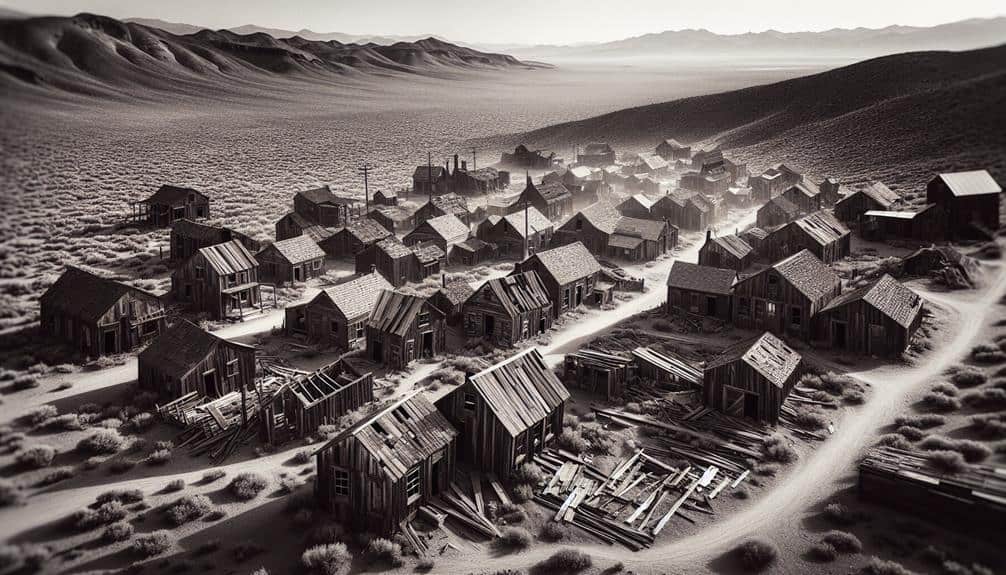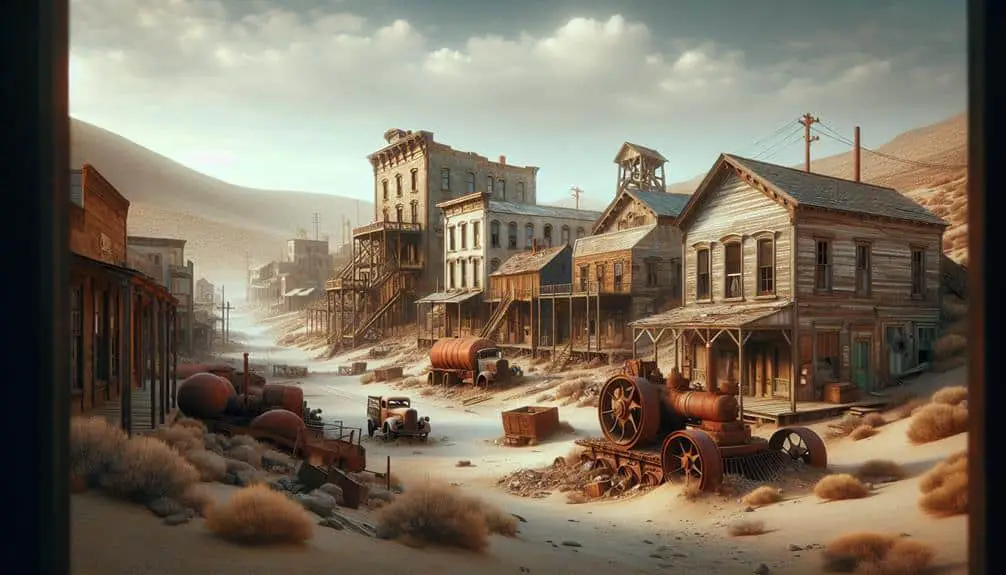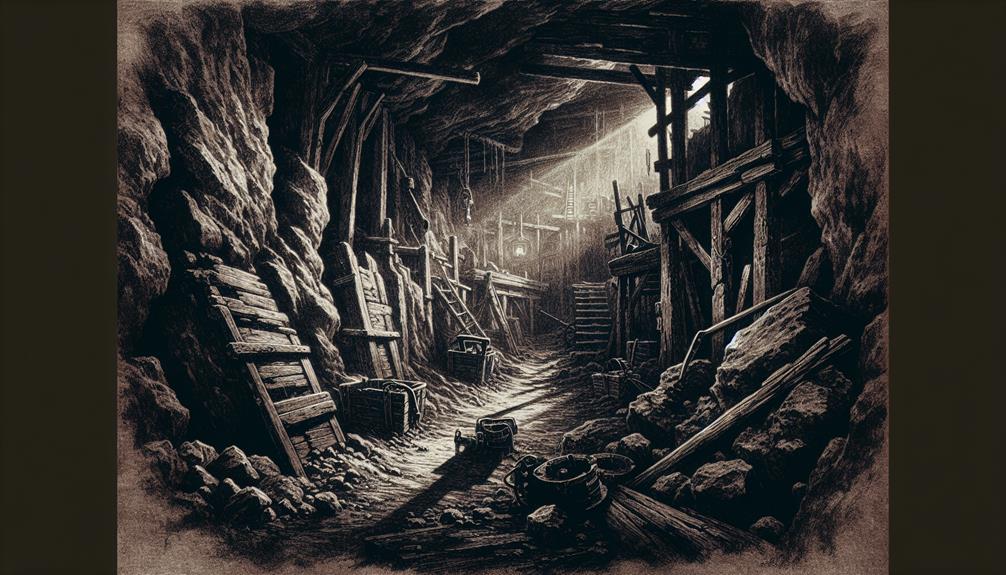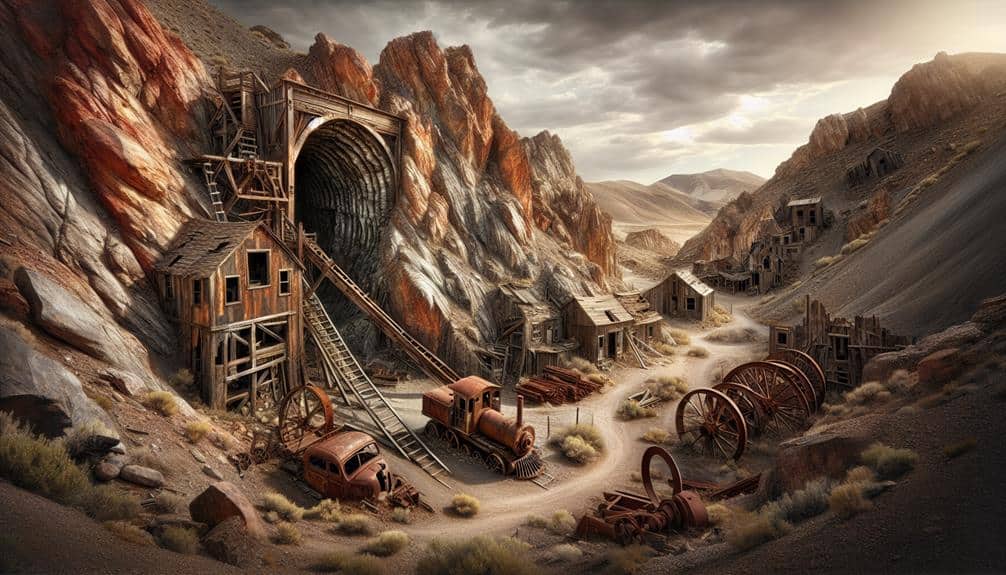Explore Nevada’s ghost town architectures – they embody a blend of frontier aesthetics and practicality, shaped by the mining boom and industrial revolution. These structures showcase pioneers’ resilience through wooden buildings with corrugated metal roofs. Preserving Western heritage, they connect you to the enduring spirit of settlers. Reflecting past economic prosperity, ornate facades reveal opulence and success. The evolution of urban planning unfolds through various architectural styles, highlighting creativity and resourcefulness of past inhabitants. These ghost town architectures influence American cultural identity, reflecting diverse traditions. Each building tells a story of challenges and triumphs, fostering a connection to collective heritage.
Key Points
- Nevada’s ghost town architectures preserve Western heritage and pioneer spirit.
- Architectural styles reflect economic prosperity and urban development of the past.
- Evolution of urban planning seen in varied architectural styles of ghost towns.
- Influence on American cultural identity through diverse architectural traditions.
- Historical significance lies in honoring pioneers, settlers, and shaping American heritage.
Influence of Mining Boom on Architecture
During the mining boom in Nevada, the architecture of ghost towns evolved rapidly to accommodate the growing population and economic demands. The industrial revolution played a pivotal role in shaping the structures of these towns, with a focus on functionality and efficiency. The frontier aesthetics blended with the necessity for practicality, resulting in a unique architectural style that reflected the rugged yet enterprising spirit of the West.
As mining activities flourished, makeshift camps transformed into bustling towns almost overnight. The need for housing, businesses, and infrastructure led to the rapid construction of wooden structures, simple in design but robust in nature. These buildings, often characterized by their corrugated metal roofs and wooden facades, stood as demonstrations to the resilience and adaptability of the pioneers who inhabited them.
The blend of frontier aesthetics with the demands of the industrial revolution created a distinctive architectural landscape in Nevada’s ghost towns, showcasing the ingenuity and resourcefulness of those who sought fortune in the untamed West.
Preservation of Western Heritage
The legacy of Nevada’s ghost town architectures extends beyond their historical significance, encompassing a profound commitment to preserving the rich heritage of the American West.
Western preservation isn’t just about maintaining old buildings; it’s a demonstration of the enduring spirit of the pioneers who settled these lands.
The preservation of ghost town architectures serves as a tangible link to the past, allowing us to walk in the footsteps of those who shaped the Western frontier.
Reflection of Economic Prosperity
An examination of Nevada’s ghost town architectures reveals a compelling reflection of economic prosperity that once thrived in these abandoned settlements. The architectural styles found in these ghost towns, such as the ornate facades of saloons, grand hotels, and opulent mansions, speak volumes about the urban development and economic boom that once characterized these areas. The elaborate detailing and craftsmanship seen in the buildings reflect a time when money flowed freely and residents invested in constructing impressive structures to showcase their wealth and success.
The remnants of Nevada’s ghost town architectures stand as poignant reminders of a bygone era of economic prosperity. The layout of the streets, the size of the buildings, and the materials used in construction all hint at a time when these towns were bustling hubs of commerce and industry. The architectural styles found in these ghost towns not only tell a story of wealth and opulence but also serve as a testimony to the resilience and ingenuity of the people who once inhabited these now-deserted landscapes.
Evolution of Urban Planning
Revealing the historical layers of Nevada’s ghost town architectures discloses a fascinating narrative of the evolution of urban planning in the region. Over time, urban development in Nevada’s ghost towns has undergone a mesmerizing transformation, reflecting various architectural styles that mirror the changing needs and aspirations of the communities. From the early adobe structures built by Spanish settlers to the Victorian-inspired buildings of the mining boom era, each architectural style tells a story of adaptation and growth.
The evolution of urban planning in Nevada’s ghost towns highlights the resilience and ingenuity of the inhabitants who navigated economic shifts and social changes. The layout of streets, the design of buildings, and the utilization of space all offer insights into how urban planners of the past envisioned and shaped these communities. Studying the architectural styles of Nevada’s ghost towns provides a window into the past, allowing us to appreciate the creativity and resourcefulness of those who contributed to the development of these unique settlements.
Hidden in the hills between Lovelock and Winnemucca, Unionville Ghost Town is a slice of backcountry bliss that’s practically begging for a detour off the interstate. As if being in a living ghost town (with a population of less than two dozen) isn’t cool enough, the place also boasts the cabin ruins of a pretty famous former resident, Samuel Clemens (although you might be more familiar with his Nevada-born pen name, Mark Twain).
https://travelnevada.com/ghost-town/nevada-ghost-towns/
Impact on American Cultural Identity
Investigating the architectural heritage of Nevada’s ghost towns reveals significant influences on shaping American cultural identity. The unique blend of architectural styles found in these abandoned settlements reflects the diverse tapestry of American traditions that have influenced the nation’s cultural landscape. From the rustic wooden structures of the Gold Rush era to the ornate Victorian buildings that stand as proof of the prosperity of the past, Nevada’s ghost town architectures showcase the evolution of American design sensibilities over time.
By preserving these architectural remnants, we not only honor the pioneers and settlers who once called these towns home but also contribute to the cultural preservation of our nation’s history. These ghost town architectures serve as tangible reminders of the challenges and triumphs faced by earlier generations, fostering a sense of connection to our collective past and instilling a deeper appreciation for the rich tapestry of American heritage.
In essence, exploring the architectural legacy of Nevada’s ghost towns allows us to investigate the roots of American cultural identity, providing valuable insights into the diverse influences that have shaped our nation’s architectural traditions.
Frequently Asked Questions
How Did the Architecture of Nevada’s Ghost Towns Influence the Development of Other Western Towns During the Same Time Period?
As you explore the architecture of Nevada’s ghost towns, you’ll notice how their rugged charm influenced the development of other Western towns. Their unique styles, born out of necessity, shaped the landscape of the era.
What Specific Preservation Efforts Have Been Made to Protect the Unique Architectural Styles of Nevada’s Ghost Towns?
To protect the unique architectural styles of Nevada’s ghost towns, preservation efforts include restoration projects, documentation of structures, and educational programs. These initiatives aim to safeguard the historical significance and cultural heritage of these buildings.
How Do the Abandoned Buildings in Nevada’s Ghost Towns Reflect the Economic Downturns That Led to Their Decline?
As you explore Nevada’s ghost towns, you’ll notice the abandoned buildings echoing economic hardships. Each structure stands as architectural symbolism, reflecting the downturns that led to their decline, telling stories of boom and bust.
How Have Urban Planning Principles Evolved in Response to the Architectural Layouts of Nevada’s Ghost Towns?
As you explore Nevada’s ghost town architectures, you’ll witness an evolution reflecting urban planning principles. The layouts influence modern planners, symbolizing adaptability and resilience to changing environments. These deserted structures hold lessons for future city designs.
In What Ways Have Nevada’s Ghost Town Architectures Influenced Popular Culture and Media Representations of the American West?
When exploring Nevada’s ghost town architectures, you’ll find they’ve left a lasting mark on media representations. Their unique blend of Western influence has seeped into popular culture, shaping how we envision the American West.



